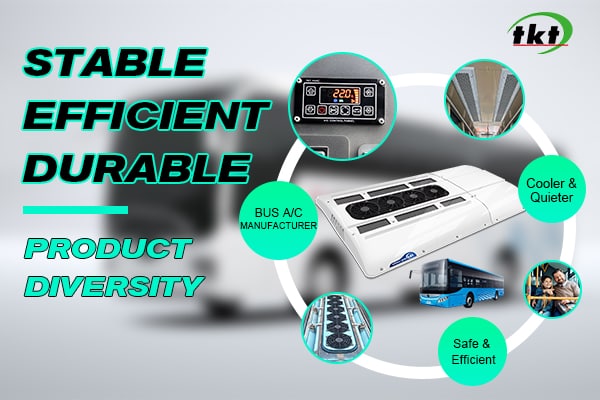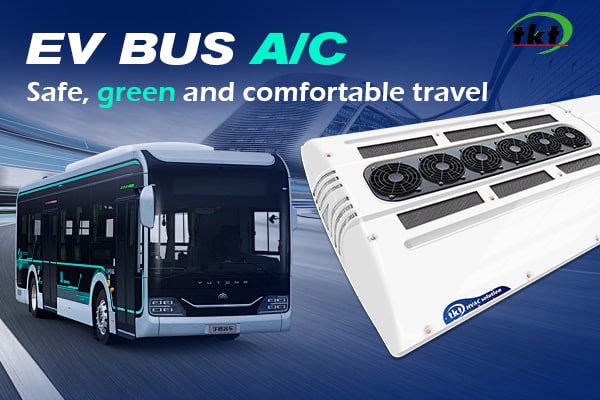Memilih sistem penghawa dingin yang sesuai untuk bas anda adalah penting untuk memastikan perjalanan yang selesa untuk penumpang, terutamanya ketika cuaca panas. Dengan pelbagai pilihan yang ada, it can be overwhelming to determine which system best meets your needs. In this comprehensive guide, we will delve into the different types of bus air conditioning systems, their components, performance standards, and how to choose the most efficient and economical option for your vehicle.
Understanding Bus Air Conditioning Systems
Types of Air Conditioning Systems
Bus air conditioning systems can be categorized into two primary types: Original Equipment Manufacturer (OEM) sistem dan sistem pasaran selepas.
– Sistem OEM: Sistem ini disepadukan ke dalam bas semasa pemasangannya. Mereka direka bentuk untuk berfungsi dengan lancar dengan sistem HVAC sedia ada bas, memastikan prestasi optimum dan kebolehpercayaan.
– Sistem Pasaran Selepas: Dipasang selepas pengeluaran, sistem ini sama ada boleh diikat ke dalam sistem HVAC papan pemuka sedia ada atau berfungsi sebagai unit kendiri. Mereka menawarkan fleksibiliti dan boleh disesuaikan dengan keperluan penyejukan tertentu.
Pada masa lalu 24 tahun, TKT EV Solution telah berkembang menjadi OEM pilihan untuk 100% penghawa dingin bas China dan sistem pengurusan haba bateri, seperti Yutong, Nanjing Jinlong, Xiamen Jinlong, dan lain-lain. (Bus Air Conditioners), CIMC, Xinfei, Hongyu, dan lain-lain. Di pasaran antarabangsa, TKT is the OEM of Tata Motors, Tata Marco Polo, Daewoo Motors, dan lain-lain., dan eksport ke lebih 85 negara yang mempunyai pusat jualan dan perkhidmatan.
Komponen Utama
A high-quality bus air conditioning system comprises several crucial components:
– Pemampat: Jantung sistem, typically mounted on the engine or a separate power source, compresses the refrigerant and circulates it through the system.
– Penyejat: Located in the driver’s area or throughout the bus, the evaporator cools the air by absorbing heat.
– Pemeluwap: Mounted on the roof or skirt, it releases the absorbed heat to the outside air.
– Kawalan: These include switches, thermostats, and electronic controls to manage the system’s operation.
– Additional Evaporators: These can be hanging or flush-mounted, ensuring uniform cooling throughout the bus.

Selecting the Right System
Performance Standards
When selecting an air conditioning system for ev buses, it is essential to consider the performance standards set by industry authorities. The National Congress of School Transportation and the American Public Transit Association provide guidelines to ensure systems meet minimum cooling requirements.
– National School Bus Specifications:
— Standard Performance: The system should cool the interior from 100°F to 80°F within 30 minit.
— High Performance: The system should cool the interior from 100°F to 70°F within 30 minit.
– American Public Transit Association Specifications:
— Capacity and Performance Requirements: Sistem harus mengurangkan suhu petak penumpang daripada 115°F kepada 95°F dalam 20 minit selepas enjin dihidupkan.
— Keadaan Ambien yang Lebih Panas: Sistem harus mengurangkan suhu daripada 110°F kepada 70°F (±3°F) dalam 30 minit untuk 30-, 35-, dan bas 40 kaki.
Pertimbangan Kapasiti BTU
Memahami BTU (Unit Terma British) kapasiti adalah penting dalam menilai keberkesanan unit sistem AC. BTU mengukur jumlah haba yang diperlukan untuk menaikkan suhu satu paun air sebanyak satu darjah Fahrenheit.
– Kapasiti Kasar: This is the lowest capacity among the evaporator, pemeluwap, and compressor, representing the system’s weakest link.
– Net Capacity: Though rarely used, this method employs multiple simultaneous equations to balance the system.
It is important to note that there is no universal BTU rating method in the bus air conditioning industry. The most reliable way to assess a system’s performance is through a pull-down test, where the system’s ability to cool the bus interior is measured under specified conditions.
Practical Recommendations
– Work with Your Dealer: Collaborate with your dealer to select a system tailored to your bus’s cooling needs. Consider the power draw of the system to ensure it does not overburden the vehicle’s alternator capacity.
– Performance Pull-Down Test: Require a performance pull-down test to evaluate the system’s ability to cool the bus interior effectively.
– Standardized BTU Ratings: Insist on BTU/hour capacities recorded in an industry-standard format, such as those provided by the Society of Automotive Engineers (SAE).
Kesimpulan
Choosing the right air conditioning system for your bus requires careful consideration of various factors, including system type, components, performance standards, and BTU capacity. By adhering to industry guidelines and working closely with your dealer, anda boleh memastikan bahawa bas anda dilengkapi dengan sistem penyejukan yang cekap dan berkesan, menyediakan persekitaran yang selesa untuk penumpang dan meningkatkan pengalaman perjalanan keseluruhan.



